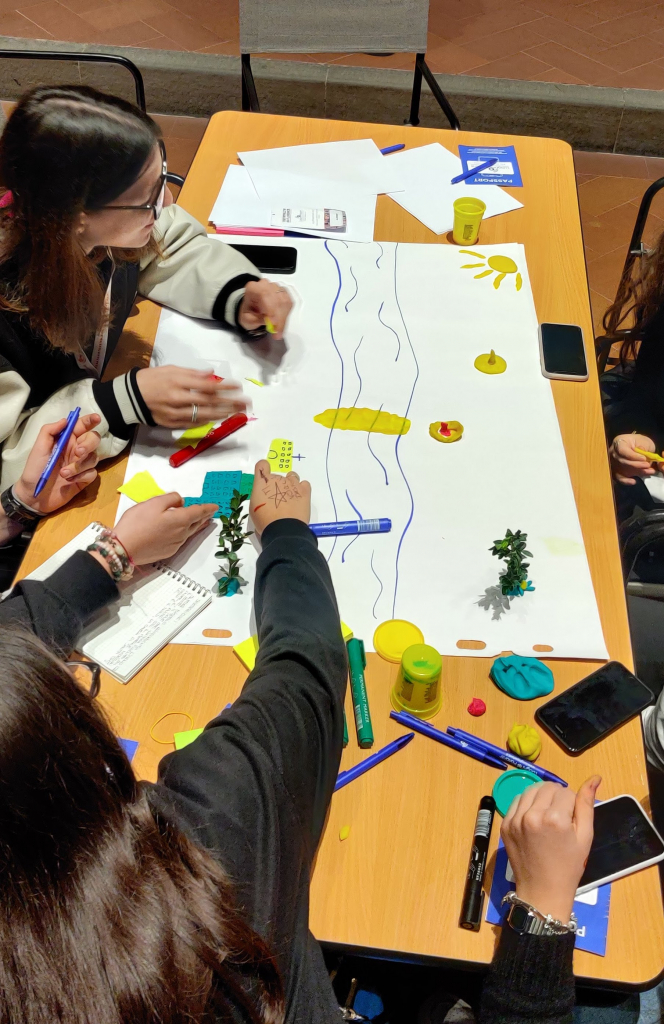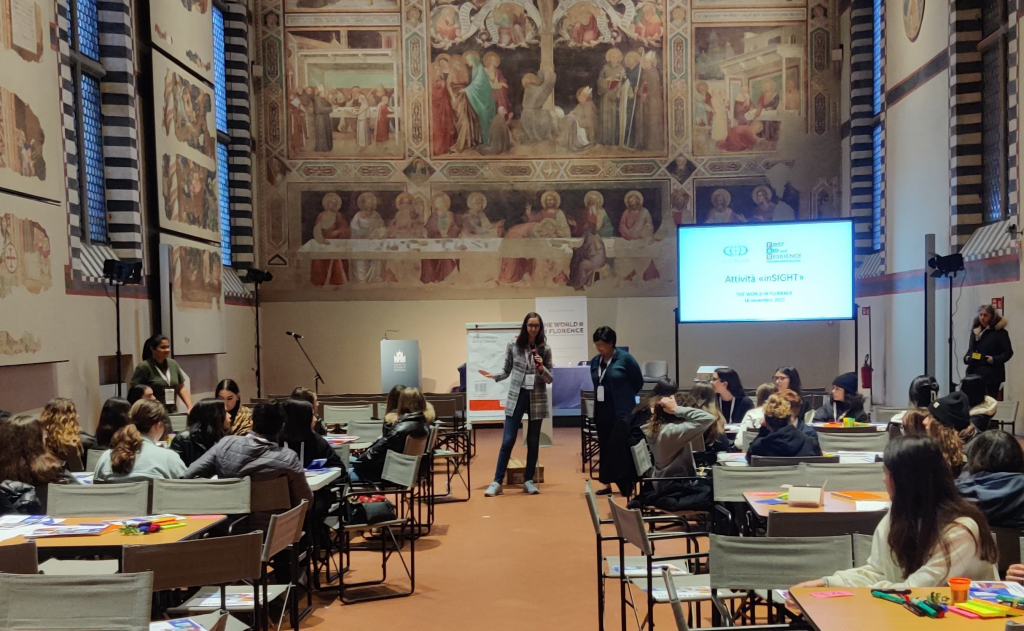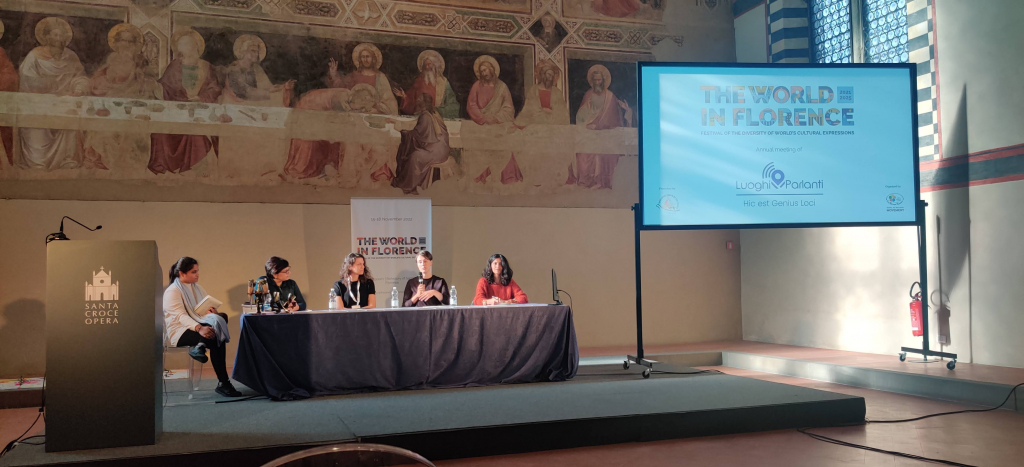Through a participatory game on disaster risk governance and two formal panels on climate action and peacebuilding, ICCROM’s First Aid and Resilience (FAR) Programme engaged 90 high school kids and a diverse heritage community at “The World in Florence,” an international festival about the diversity of the world’s cultural expressions, organized by the Romualdo Del Bianco Foundation in Florence, Italy, from 15 to 18 November 2022.
What does cultural heritage mean to high school students?
On the event’s first day, Gaël de Guichen, Special Advisor to the Director General of ICCROM, and FAR team member Michela Masciocchi engaged 90 local high school students in an educational game called “InSight,” which we developed to enhance awareness about disaster risk governance. The game offered the students an opportunity to build a common understanding of how a place’s cultural and natural heritage contributes to capacities for disaster risk reduction, climate action and sustainable development.
The students enthusiastically played the game, working together to produce maps of their hometowns using colourful markers, playdough and sticky notes to represent places, traditions and practices that are significant to their collective identity. They discussed and identified risks, vulnerabilities and strengths that characterize their everyday environment and outlined their priorities and areas for action.
 The activity was an empowering social experience. It allowed students to express their perspectives and opened a channel of communication with local institutions and organizations to understand young residents’ concerns and ideas. Detailed maps gave voice and visual expression to the students' thoughts, narrating how the younger generation perceives cultural heritage and the risks to it.
The activity was an empowering social experience. It allowed students to express their perspectives and opened a channel of communication with local institutions and organizations to understand young residents’ concerns and ideas. Detailed maps gave voice and visual expression to the students' thoughts, narrating how the younger generation perceives cultural heritage and the risks to it.
It emerged that, from the students’ perspective, cultural heritage is a mix of bridges, historic buildings, artworks, traditional foods, sports fields and parks. Green and blue were the dominant colours in the maps, signalling attachment to natural spaces and their importance as gathering places since the pandemic.
Students identified many threats to their heritage, including pollution, social violence and disrespect for others. However, few mentioned natural disasters, and many had difficulty identifying relevant organizations to contact in case of need, revealing an important gap. Collaboration between local communities and reference institutions, including schools, local administrations, health services and law enforcement agencies, emerged as a solution to address the main weaknesses, namely the sense of insecurity and lack of civic responsibility. In particular, students emphasized the unifying role that memory plays in strengthening social cohesion, offering insights into the need to integrate intergenerational knowledge exchange into the sustainable development of their cities.

Talking to the community about the link between heritage, climate and peace
On the festival’s final day, the FAR team moderated two thematic panels, “Heritage in Adapting to and Mitigating Impacts of a Changing Climate” and “Heritage for Sustainable Peace.”
 The first panel, moderated by FAR team members Aparna Tandon and Jui Ambani, explored how we can use the knowledge embedded in cultural heritage to find mitigation actions, help adapt to a changing climate and reduce disaster risks. The panel featured three case studies:
The first panel, moderated by FAR team members Aparna Tandon and Jui Ambani, explored how we can use the knowledge embedded in cultural heritage to find mitigation actions, help adapt to a changing climate and reduce disaster risks. The panel featured three case studies:
- Catherine Forbes from Australia showed how to measure the impacts of climate change on the heritage of The Rocks (Sydney).
- Özden Coşkun Öner from Turkiye presented an innovative rehabilitation project conducted in the Historic City Centre of Izmir and developed through a participatory design process based on the traditional knowledge of the local community.
- Chiara Arrighi from Italy gave insight into effectively conducting flood risk assessments and using them to safeguard cultural heritage sites while enhancing resilience. Arrighi’s examples demonstrated that traditional and indigenous knowledge are crucial to developing place-specific climate change mitigation and adaptation strategies. Intersectionality and people-based approaches were pointed out as key to conducting comprehensive risk management and integrating cultural heritage into climate action.
The second panel, moderated by FAR team members Aparna Tandon and Mohona Chakraburtty, considered the complex link between cultural heritage and peace. It brought together peacebuilders and heritage professionals to examine heritage’s role in transforming protracted conflicts and building lasting peace.
The panel drew from the experiences of:
- Nathalie Paarlbers’ work in sustaining textiles traditions of minority groups in Myanmar;
- Marija Kamber’s development of a community museum with a “war exhibition” in Goražde (Bosnia and Herzegovina); and
- Eva Ziedan’s promotion of agricultural rehabilitation of the Ghab Plain in Syria.
We discussed how heritage can empower local communities, promote dialogue and support the recovery of war-torn societies. The discussion prompted many questions and direct testimonies from the audience, both in-person and online, exploring the myriad ways heritage practices can help foster peace. The panel emphasized that adopting context-specific and people-centred approaches to cultural heritage management, starting from people’s experiences and everyday activities, is critical to helping people overcome the trauma of conflict, promote social cohesion and build long-lasting peace.
Recordings of all sessions are available here.
